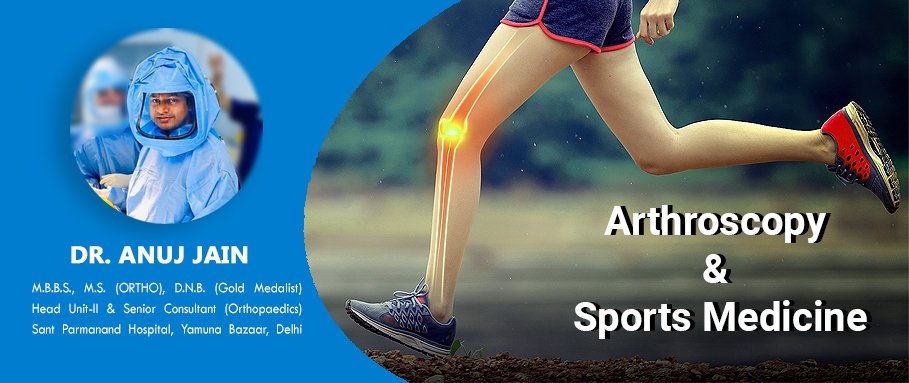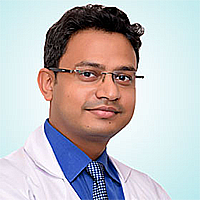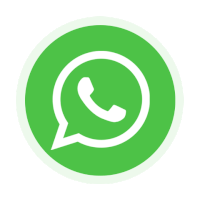Arthroscopy & Sports Medicine

Treatment
Frozen shoulder is initially treated with exercise, physical therapy, and medication or steroid injections. Most cases can be treated conservatively. Recovery usually take 6 to 12 months. If there is no improvement within 6 to 9 months, arthroscopy is done to restore movement.
Arthroscopic Adhesion Dissolution Therapy
This is a keyhole arthroscopic surgery that uses a high-frequency machine to remove adhesions and capsular scars that limit shoulder movement. Arthroscopic technique is considered one of the best and minimally invasive techniques for treating frozen shoulder. Average stay – 1 day entry Postoperative physiotherapy - intensive care Call us for more information.
Arthroscopic Rotator-Cuff Repair by Dr. Anuj Jain
Rear of rotator cuff around the shoulder joint is a group of muscles called the rotator cuff, which is the main muscle of the shoulder joint. These muscles can be torn by injury in young people. However, in older people, it usually ruptures due to degeneration (wear) without causing significant trauma. Patients complain of pain and weakness in the shoulder, and in the long term can lead to arthritis of the shoulder joint. Arthroscopic rotator cuff repair - Shoulder arthroscopic surgery - A rotator cuff tear does not heal spontaneously. For partial or small lacerations, conservative treatment can be attempted. However, if the problem persists or the laceration is large, surgical repair is required. Previously, open surgery was used for repair, but now the entire repair can be done arthroscopically (keyhole technique). A small hole is made in the skin over the shoulder joint and a small camera is inserted through the hole to perform the repair. This reduces pain and restores function.
over your shoulder- The shoulder joint is covered with layers of muscle that help move the arm. The deepest layer he consists of four major muscles, collectively called the rotator cuff. Cuffs have many purposes, but their primary function is to elevate the arm. The rotator cuff is located under the shoulder bone called the acromion. The cuff space is very tight and in many patients the cuff can rub against the underside of the acromion. This can lead to painful inflammation, especially with arm strain and when sleeping at night. Continued rubbing of the rotator cuff below the acromion can cause a small hole in the rotator cuff and a tear.
What are the symptoms?
Initially, the only symptoms are pain when using the arm and pain at night, which may interfere with sleep. If the laceration is small, the arm may still be fully functional. As the tear grows, the arm becomes weaker, and eventually the arm may not be able to lift at all. Rarely, arthritis can develop in the shoulder joint.
What tests are done?
A doctor makes a diagnosis based on symptoms and laboratory tests. X-rays are done to check for bone disease. An MRI is done to confirm the diagnosis and determine the degree of rotator cuff tear, degree of retraction, and fatty degeneration.
What is the treatment?
Treatment is by keyhole surgery (arthroscopy). The rotator cuff tear is repaired and secured to the bone with a suture anchor. It is important to repair a torn rotator cuff tendon as soon as possible because the tendon may recede if it is prolonged, and the quality of the tendon deteriorates, resulting in a poor prognosis after surgery. Arthroscopic rotator cuff repair has good to excellent results in patients who are properly indicated and use the right technique.
Contact your surgeon for further details
Arthroscopic Bankart repair for recurrent shoulder dislocation
Recurrent shoulder dislocation
Recurrent shoulder dislocations occur in young people and often dislocate the shoulder. This causes extreme pain and discomfort to the patient. This is usually the result of injury to the shoulder joint capsule and ligaments due to trauma. The problem recurs so frequently that patients are constantly afraid that the shoulder will dislocate.
How is the treatment done?
If the shoulder is dislocated and repositioned, you will be given pain medication and an arm bag to rest the shoulder. Exercise is recommended once the pain subsides and the shoulder is able to move again. Definitive treatment is surgery to sew the torn labrum back into the fossa (glenoid fossa). The most commonly performed procedure is the so-called bankart restoration. This can be done with arthroscopy, which uses a small keyhole incision and a camera to look inside the joint and repair torn structures.
Arthroscopic Bankart Repair
Arthroscopy has revolutionized the treatment of this problem. Previously, open surgery was performed, which caused stiffness. However, torn ligaments are now repaired by arthroscopic techniques, which involve making a small keyhole incision in the shoulder joint and repairing the torn joint capsule and labrum. This technique has no stiffness or restriction of movement and has an excellent success rate.Advantages of arthroscopy:
- Early recovery.
- Less blood loss.
- After surgery after surgery.
- The arm will be placed in an arm pouch for 2-3 weeks.
- Light pendulum movements are started the day after surgery. The stitches will be removed after 2 weeks. Physical therapy, initially under the supervision of a team of physical therapists and then by the patient at home, should be followed up regularly based on OPD.






